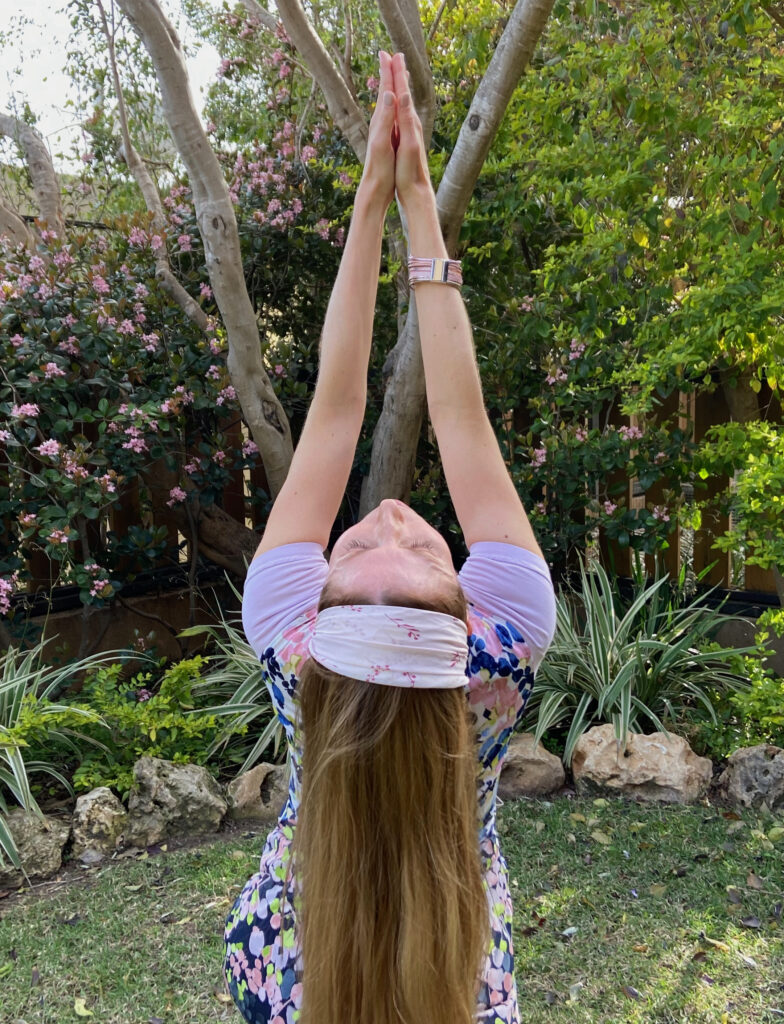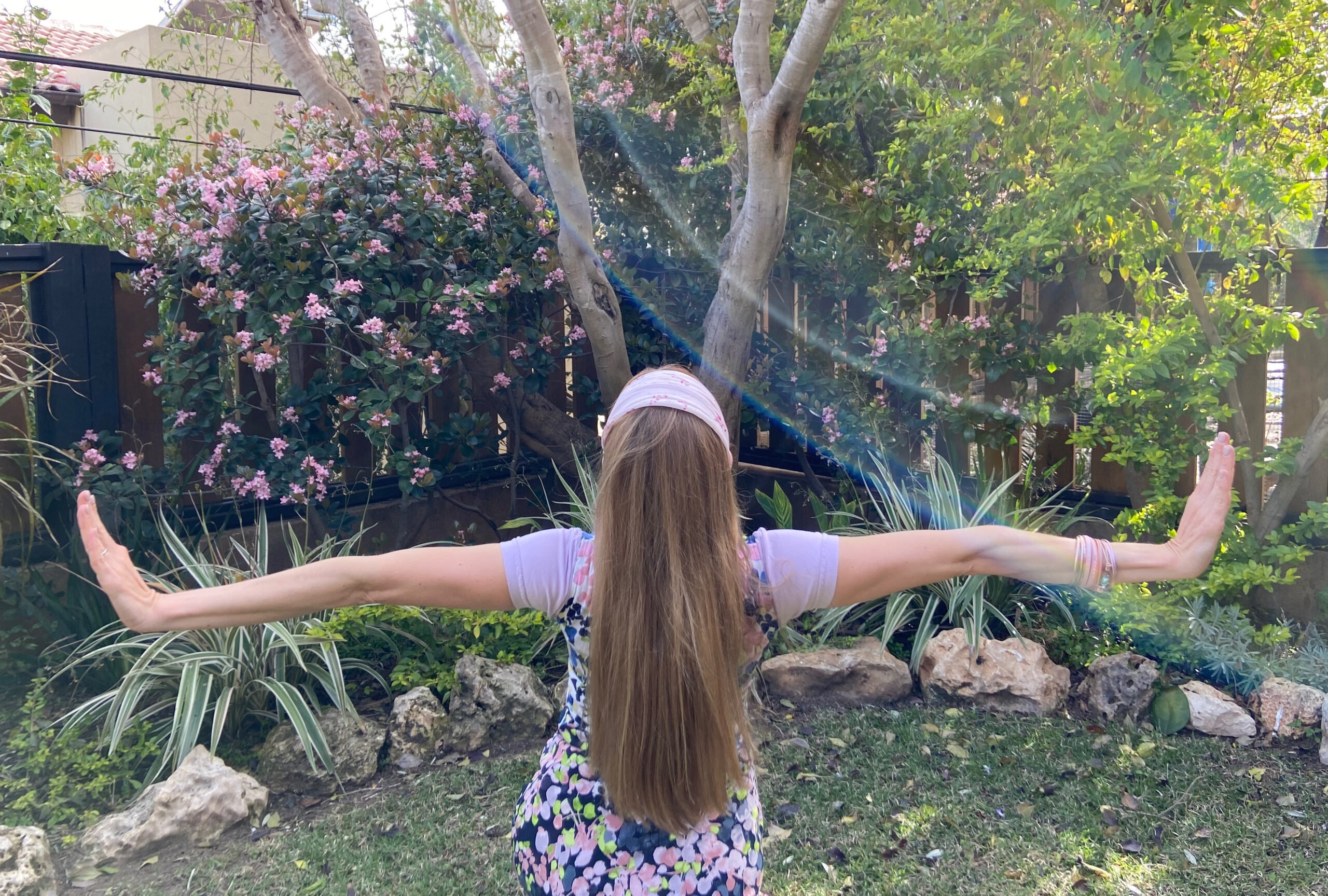
We all want to be free. To feel liberation in our circumstances, in our bodies, our minds. How can our yoga practice deepen our understanding of the paths to freedom, and how does that relate to our lives off the mat?
Qualities of Nature – The Gunas
Our mental, physical, emotional and spiritual health depend on how successful we are at balancing the forces surrounding us, inside and out. Are we tossed about by the vicissitudes of life, constantly up and down? Or are we stuck in the mud, without inspiration, feeling dull and depressed? Are we stable, peaceful, experiencing clarity and balance?
According to yogic philosophy (as in Ayurveda), we are governed by different tendencies of nature called gunas. There are three gunas: tamas, rajas and sattva. All matter and consciousness are a combination of these three qualities, and they are in constant flux.
The quality of tamas is dull and inactive, lethargic. The tendency is heaviness, inertia. Rajas is the quality of passion, energy. The tendency towards action, motion. These qualities can be expressed positively or negatively, but an excess or lack of any tendency is imbalance.
Finally, there is the quality of sattva, which is balanced, pure, harmonious, peaceful.
We are a combination of all of these qualities, with differing proportions at different times. I sense in myself a particular tendency dominating much of the time, but all three are present, and I have the ability to alter the state in which I am in with the choices I make.
Our gunas are influenced by our actions. This includes the food we eat, the people we spend time with, the activities we undertake, our speech, the media we imbibe and really every decision we make.
There is a real snowball effect to our actions. Right action leads to more right action, so even a small step in the direction we wish to travel gains momentum. Of course the inverse is true as well.
Can you recognize within yourself what tendency dominates? What is your nature? Do you take actions to help balance yourself?
What are some of the actions you take that cultivate a feeling of sattva, of harmony and peace?
I would say that this feeling of sattva, this experience of balance, harmony and purity is a good indication that you have found freedom.
As we explore the different paths to freedom, understanding what your gunas/tendencies are may help you to discern how to achieve freedom.
Freedom in our bodies and mind.
There is no right answer about which path to take. Most of the time we have to be dynamic in our self-exploration, realizing that different circumstances require different approaches.
Just like understanding what our natural tendencies are so that we can evolve ourselves to find more balance, the approach to finding freedom will vary depending on who we are and what our current situation is.
Fight for Freedom
The idea that we must fight for freedom is a very masculine, fairly linear concept.
As an American, I grew up with the revolutionary history of our founding fathers, with the idea of Manifest Destiny justifying the land grab and with the ideals of the American Dream. That you can do or be anything you want, if you work hard enough, have enough drive, enough ambition…No pain, no gain, right? That the world is ours for the taking, but also…
There’s no such thing as a free lunch.
I’m mashing up a lot of different philosophies and ideals, but the essence is that if you want something, you are going to have to work for it. Perhaps challenge another who has it, and fight for it. And in the process, there is a conquering of some barrier.
This idea resounds again and again in patriarchial societies in particular…to push borders, claim space, to fight for your rights. So many movements, even if they are non-violent, still have this forceful forward moving effort to break down walls.
This is an important concept. We all have a masculine side. We need to cultivate this energy. Not just for social activism but in our bodies.
And this is what is interesting to me…
In order to find freedom in our bodies, we must often push beyond our comfortable boundaries. To make space in our joints, to have greater mobility and movement. To open our chest to breathe deeper, to lengthen our spine to stand tall, to work our limbs with strength and energy to align our organs and nourish our entire body with healthy circulation.
This doesn’t happen without effort. Without physical and mental effort. We need to activate! To charge our movements with energy and enthusiam and effort to break open chains of bondage in our body!
I’m getting so riled up just writing about it, I just about let out a war cry 😉
Especially if we are a sedentary sort, this requires a huge effort to generate this energy and enthusiasm in our bodies and our pursuits.
We can achieve so much with steady diligence, determined effort, and just plain hard work! I would classify this quality of approach as rajas, the guna that I introduced earlier, corresponding to passion and motion.
We could also call it tapas…a fiery sense of self-discipline and courage that helps us to start and maintain pursuits. Of course, your tapas discipline could be applied to a less physically active practice or pursuit, as this fire within may be what you need to ignite yourself to cultivate a meditation practice, or find the energy to research, shop for and cook for a more healthy diet.
Because sometimes, it is necessary to fight for our freedom. If there is a barrier we wish to conquer, we will most likely need this fire.
Practice Fighting for Freedom
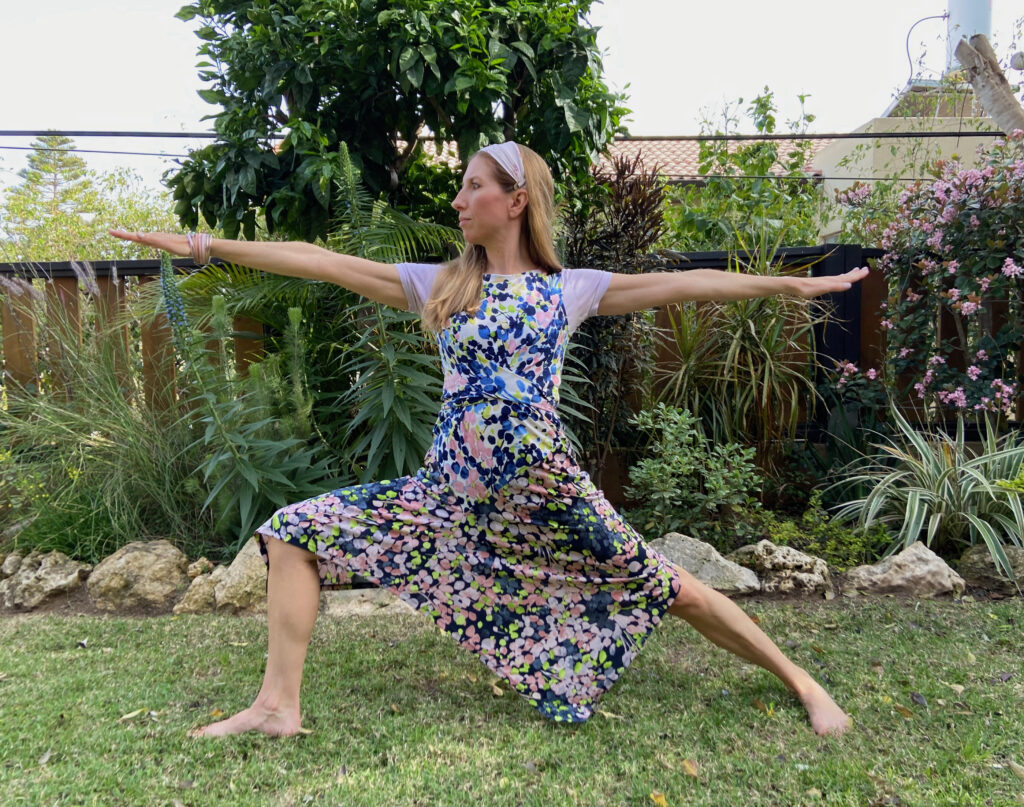
In Virabhadrasana II, it is rather easy to cultivate a sense of fight as it is one of the Warrior postures. It is very grounded and stable, but the arms and legs work strongly to open the chest and pelvis. Consider trying this yourself and observe what type of sensations arise, beyond the physical. Do you feel assertive or aggressive? Powerful? Can you feel an inner fire build?
It is also fun to experiment with practicing this pose with a tamasic (heavy and dull), rajasic (energetic and passionate) and sattvic (balanced and peaceful) quality. Just focus your mindset to those thoughts and see what the body does. What feels like the most appropriate presentation for you?
Letting Go for Freedom
Okay, let’s flip the coin now and explore what it might look like to “Let Go for Freedom.”
There are some barriers that cannot and should not be eliminated with force.
Sometimes the only way to progress is to let go.
Many barriers in our bodies and in our lives are the result of such a tight grip, that when we begin to loosen our palm, we can start to dissolve the obstacles in our way.
When I began my more serious yoga practice, deepening through my teacher training, this approach was revelatory to me. I looked back on my life and saw that because of my efforts to achieve and progress in the more Western way – the Fighting for Freedom way – I had hurt myself so many times. And probably hurt others too.
I dealt with painful injuries in my career as a dancer, I had neglected important relationships because I was blinded by certain ambitious, selfish pursuits, and had pushed myself too far, too long and too hard over and over and over.
The revelation was that I didn’t always need to work so hard to produce results. In fact, that hard work was producing all kinds of results that I didn’t want!
So, particularly in the physical yoga practice, you can begin to explore where are the areas that open up with the release of effort. I’m sure you can identify times when you stay in a passive stretch that you actually find progress by letting go of muscular tension and effort. When you find pockets of tightness, congestion and feeling “stuck”, and are able to breath into them and through them, you can gently liberate those areas.
Have you ever had a massage and find that if the pressure is too much for you, you clench up and feel worse as you resist? But if the pressure is just right, you can deeply release physically and mentally?
Your yoga practice can help you tremendously to cultivate a receptive mind and body state. This is a feminine energy actually, and we are often criticized in the Western world that this is lazy or unproductive. What a shame that is! This energy, this ability is equally important, and ironically can facilitate the greatest progress and results, particularly in those that are used to being in a high level of control. Further, as we are all a balance of energies, this applies to all humans, regardless of gender.
And it doesn’t just apply to our physical selves, or in our yoga practice, of course. There are many interactions with others, in our jobs and family life, where we find that we need not push an agenda. By releasing or maybe even taking a step back, we may be giving another individual the opportunity to develop and progress. Sometimes, just patience and time will allow a problem to resolve.
And certainly, finding forgiveness, either by forgiving others or ourselves, is one of the bravest expressions of letting go.
The use of our breath is a tremendous tool that is always at our disposal.
We can find massive amounts of freedom when we have to courage to let go of that which is holding on so tightly.
It is actually incredibly powerful to watch a wall fall down with the softest of exhalations.
Practice Letting Go for Freedom
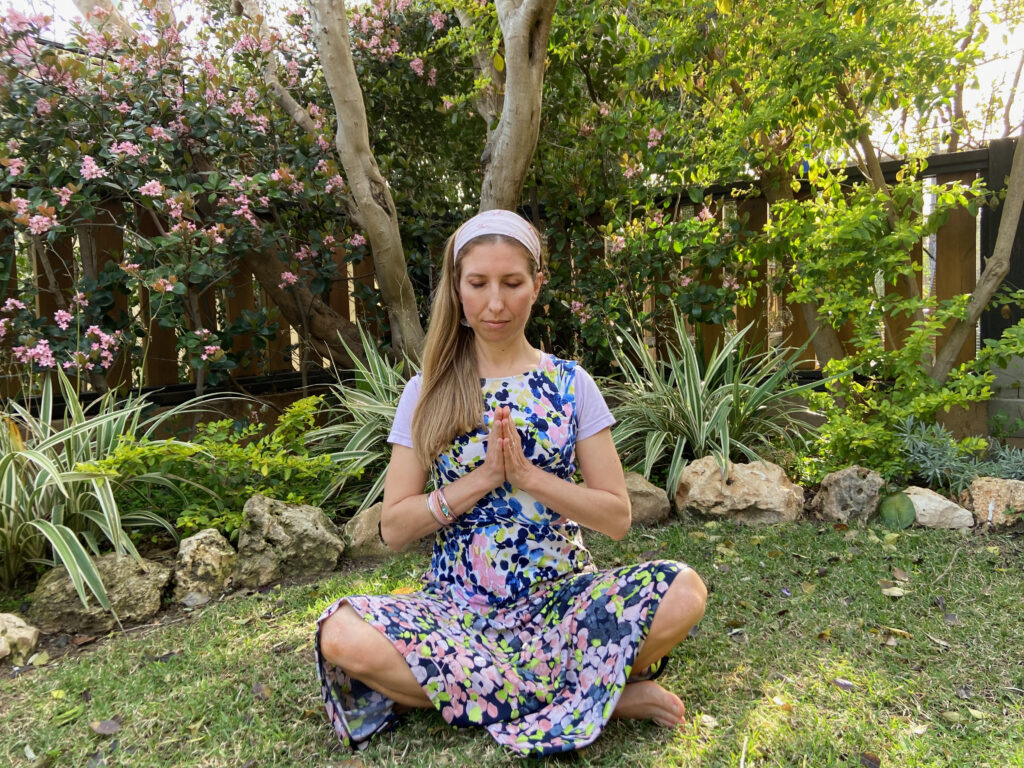
The joining of the palms together in the center of the chest is a simple but powerful gesture. The centeredness of the action draws together the right and left sides of the body and mind, it elevates and opens the heart and lungs and helps us to feel connected and peaceful.
You can practice this Mudra (hand position) in many body positions, so get comfortable. If it is difficult to sit for 5 minutes unsupported, sit on a pillow with your back to a wall for support.
In this practice of letting go, we will not be stretching our bodies at all, but rather our minds. Use the centeredness of the posture, with your eyes closed, to focus on your breath. Really experience your breath entering and exiting your body through your nostrils. Make an effort to sit tall, with your spine long, utilizing the connection of the base of your thumbs to the lower sternum to lift and spread the skin of the sternum.
Observe any areas of tightness in your body. Does your breath catch somewhere? Is your upper back fatigued? Are your legs tense? Are you gripping your jaw or furrowing your brow?
Try to release these pockets of tension, utilizing your breath. Realizing that you still must hold on a bit to sit upright, with the palms together.
Consider for yourself if there is an area in your life that you are holding onto with a death grip. When you think about this, where do you feel it in your body? What aches when you think about this? What hurts? Can you hold that hurt, gently, in the palms of your hands, and breathe into it? Can you use your breath to encourage some gentle movement into this area?
Hold it for another few moments, noticing what arises, and breathing with it.
Then, lowering your head to your heart and your hands, exhale and let go. Release your palms.
If you can, lie down for a few moments, flat on the floor in Savasana, Corpse Pose, and breathe through the letting go.
When you feel ready, draw your hands into your abdomen, roll to your right side, and move on.
Fences for Freedom
This path to freedom is actually about creating boundaries. Ironically, many of us feel better, feel more free when we are in some kind of structure. I’m of course not talking about an oppressive environment, but reasonable structure.
Some boundaries in fact give us the freedom to explore more securely (as a mother of four, I know that boundaries are super important for kids – from toddlers to teens – and they are for us adults too), can calm our nervous system, and can provide the gentle feedback and pressure we need – acting like a springboard that we can bounce off of.
Physically, when we use a wall in our yoga practice, we can find at times support, and at other times a firm surface to push against to make space or find length in the body. To find freedom in the body.
As my teacher Eyal Shifroni often says, “It is hard to push against air.”
Having tangible borders and boundaries is also important on many other levels.
As women, this is an especially important skill for us to cultivate. That our bodies are our own, that we can say “no,” that we have limits to be respected.
Further, I’m sure we can all relate to not guarding our time well enough, to feeling pressured to say “yes” when we would have rather said “no” to a commitment, to indulging when we wish we hadn’t. To circle back to the beginning of this email, guarding how much media we are exposed to is also very freeing – both emotionally and as a tangible chunk of time. How many of us have gotten into a time suck on social media, planning to just check the time on our phone and surfacing twenty minutes later (but forgetting to check the time). Screen time limits, anyone?
Within religion, there are numerous examples as that which is separated becomes elevated…becomes holy.
By establishing firm lines, we gain greater freedom, and appreciation for that freedom, in the space that we have set aside.
Practice Fences for Freedom
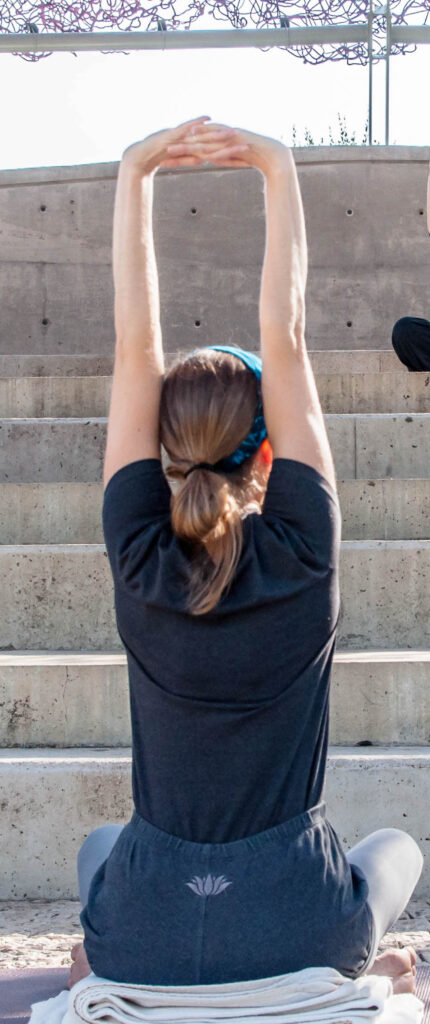
In Urdhva Baddhanguliyasana, Upward Interlocked Fingers Pose, we use our own body to feel how making the boundary of our arms allows us to create more space and freedom in the chest and torso.
Interlock your fingers, turn your palms out, connect your thumbs and inhale your arms overhead. Work within the boundaries of this structure, this framing that you established. Feel that while it is an effort to keep the arms overhead, the interlocking provides resistance to move the arms higher and perhaps open the shoulders more.
A sustained stay in the pose encourages greater circulation and more rapid breath, and the full benefits of freedom in the chest and upper body is experienced upon release of the pose.
Experiment with a loose interlocking and a firm (to the roots of the fingers) interlocking. Be sure to alternate the interlocking of fingers each time so you remain symmetrical. Notice what is more effective for you.
The next exercise, and this is off the mat, is to check in with how often and automatically you say “yes” to commitments when you really want to say “no.” Consider, especially for non-urgent social engagements that you are not excited about, if you can decline, perhaps once a week, and give yourself the gift of freedom of your own time. You don’t have to make excuses, or come up with a lie, you can simply say “no thank you.” If you’ve never done this before, get ready for a truly empowered experience!
Acceptance for Freedom
Finally, accepting where we are in the world at the moment is very freeing. This is similiar to the process of letting go, but is even less active.
To simply be at peace with who you are, imperfections and all, is often a challenge. There is so much that needs to be “fixed!” I have so many ideals and dreams and visions, that my mind is a busy place. When I get too caught up in the future, with plans and to-do lists and goals, I feel trapped by expectations, and self-conscious that I’m not where I’d like to be.
I can also project this attitude on to others, my family members especially. When I or they don’t live up to those goals and ideals, disappointment is bitter and frustrating for everyone around.
First step to achieving freedom in these situations is to cultivate some self-acceptance and self-love. It doesn’t mean you are settling for a life where you don’t grow, learn, achieve or gain wisdom. It just means that right now, in this snapshot of time, you’re okay. In this present moment, you’re good enough. You can be loving and compassionate to yourself. Rinse and repeat with your loved ones.
Two essential aspects of spiritual life, according to the Yoga Sutras, are Abhyasa and Vairagya. Abhyasa is perseverance in practice…in fact, much of the first three paths to freedom depend upon this effort to apply our selves regularly and with devotion to our practice (our journey for self-improvement, transformation…). But this discipline and perseverance is balanced by the aspect of Vairagya, which is detachment or renunciation. Vairagya is often considered detachment or dispassion from material desires, but that is not the full picture. It is also the release of our egoistic will. In my opinion, here lies a place for devotion.
I believe that even greater freedom can be won in these situations with renunciation of our will…to give over control. To a higher power, God, the universe…trusting in the infinite beyond us. When we allow some of the burdens of our will to be absorbed into a divine guardianship, a lightness is born in the soul.
This is truly freeing, physically, spiritually, emotionally…
For those that don’t believe in a higher power, this seems to be an impossible task. However, I think, like all things, that it can be cultivated.
At it’s core, faith is a relationship of sorts. It is humbling to begin, but if we start with the premise that we don’t know everything, and that we don’t understand all the workings of the world, then there is the space and seed to germinate the beginnings of that relationship.
Meditative practices (including prayer), counting your blessings, acting generously, and looking for the good in others help to expand our consciousness and open our hearts. Singing, dancing and moving your body with breath and awareness (yoga!!) foster an embodied sense of spirituality.
It is not a coincidence that so many yogis are spiritual types. As I always say, the practice of yoga almost magically and unintentionally opens up a spiritual space within. What you fill it up with is your choice…whatever your religion or belief system is, it can enter this spiritual space and manifest in a deeper physical connection to it. Most religions have ritual and formalized aspects and actions. In my experience, my yoga practice has enhanced my connection to God in my body and in those rituals.
Again, acceptance is not settling. Further, no one path is appropriate all the time. We must be discerning in our survellience of our situation to be able to know which path to take.
Practice Acceptance for Freedom
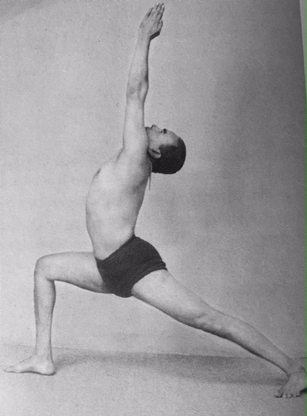
In this pose, Virabhadrasana I – Warrior I, you’ll notice that I’m using BKS Iyengar himself to demonstrate the pose. This is quite intentional. There is always so much to work on in this posture, that I often feel asymmetrical and self-conscious. It is hard for me to settle, because my body won’t cooperate with everything that my mind wants to happen.
However, this is the point of the exercise. Choose a pose that is accessible, but challenges you. That disturbs your mind because you know you aren’t getting it totally right.
Take the posture, do your best to refine it, and then stay in the pose. Remain there as you work to let go of your self-judgment, your inner critic, your analytical brain that wants to keep working on making it better.
Use your breath, your compassion for yourself, and work to find acceptance. Don’t try to improve the pose physically! Don’t fidget. Just breathe into who you are and the current expression of the asana. It is your best, and it is good enough.
This particular asana, Virabhadrasana I, has a strong supplicatory energy to it. The body is in a low lunge, with the arms, gaze and chest uplifted. There is a sense of humility and supplication, as well as quiet strength. The body is low, but the soul reaches high.
I find it fitting that despite the fact that my physicality doesn’t cooperate to achieve all of the alignment actions I’m aiming for (or perhaps because of the fact?), this pose becomes an opportunity to channel acceptance and experience humility.
Experiment for yourself how this practice can truly bring you into the present moment, to experience that humility and gratitude and some love for yourself and what you are able to do.
And maybe then some acceptance will be born.
